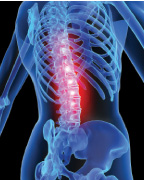
Osteoporosis and Bone Health
 |
OverviewOsteoporosis is a disease characterized by low bone mass and deterioration of bone tissue. Eventually, a more fragile bone structure results in fracture, particularly of the hip, spine and wrist. Complicating prevention and diagnosis is the fact that bone loss occurs without symptoms. Several major risk factors contribute to a diagnosis, among them:
Bone is a living tissue and is constantly building and destroying itself. Peak bone mass is achieved at age 16 in girls and age 20 in men. Women and men alike begin to lose bone in their mid-30s. Estimates of prevalence vary, but based on common assumptions of one in 4 women and at least one in 8 men over age 50, about 2 million Canadians suffer from osteoporosis. Men are thought to be less exposed due to their higher peak bone mass, no menopause-related acceleration in lost bone mass, less likelihood of fall, and shorter lifespan.2 With an aging population, incidence (new cases) is expected to double worldwide in the next 25 years.3 Research Findings
Sources:
2. Osteoporosis Canada. Available at: www.osteoporosis.ca
3. International Osteoporosis Foundation (IOF), 2002. Invest in Your Bones: Osteoporosis in the Workplace. p.17.
4. Canadian Institute for Health Information, 2009. Rise in use of common osteoporosis drugs among Canadian seniors. News release, February 12.
5. Adherence figures supplied by Amgen.
6. Op cit. IOF, 2002. Invest in Your Bones: Osteoporosis in the Workplace. p.7.
7. Statistics Canada, 2010. Vitamin D status of Canadians as measured in the 2007 to 2009 Canadian Health Measures Survey. Health Reports 21(1), 47-55.
|
